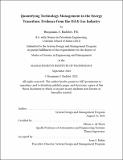Quantifying Technology Management in the Energy Transition: Evidence from the Oil & Gas Industry
Author(s)
Radelet, Benjamin S.
DownloadThesis PDF (18.58Mb)
Advisor
de Weck, Olivier L.
Terms of use
Metadata
Show full item recordAbstract
Technology plays a critical role in how companies manage and strategically reposition during periods of change, including the current transition to lower-carbon energy in the Energy Transition. While previous research has indicated associations between technology management and the Energy Transition, the ability to quantify the relationship and its characteristics has been limited due to a lack of differentiation in the public data.
This thesis explores the degree to which technology management has shifted during the Energy Transition for twelve representative companies in the Oil & Gas industry. A novel method was developed to differentiate technology patents based on the Cooperative Patent Classification’s Y02–Y04 schema for tagging Climate Change Mitigating Technology (CCMT), resulting in a three-tiered subclassification. Results of this method show that high-value innovation in the Oil & Gas industry can be categorized, on average, as 89.4% Incremental Energy, 8.3% Sustaining CCMT, and 2.3% Disruptive CCMT.
Next, this study utilized the differentiated patent data to perform Spearman rank order correlation analysis to establish the association between technology trends, corporate R&D metrics, net sales and oil price. Findings show positive correlation between Disruptive CCMTs and both Sustaining CCMTs (𝑟ₛ[202] = .55, 𝑝 = < .001) and Total R&D Patenting (𝑟ₛ[202] = .49, 𝑝 = < .001), indicating internal R&D spillover between teams.
Finally, the differentiated CCMT patent data and the correlation analyses were evaluated alongside global patenting trends to assess the rate of technological change in the Energy Transition. The findings indicate that the Oil & Gas industry has produced high-value innovations on par with the broader Energy Transition, exhibiting an Average Annual Growth Rate of 24.9% for Disruptive CCMTs and 21.4% for Sustaining CCMTs compared with an average of 24.6% for Global CCMTs. The findings also highlight an ongoing period of transition with indications of future demarcation in technology strategies. As a result of these investigations, suggestions have been identified for future research.
Date issued
2022-09Department
System Design and Management Program.Publisher
Massachusetts Institute of Technology